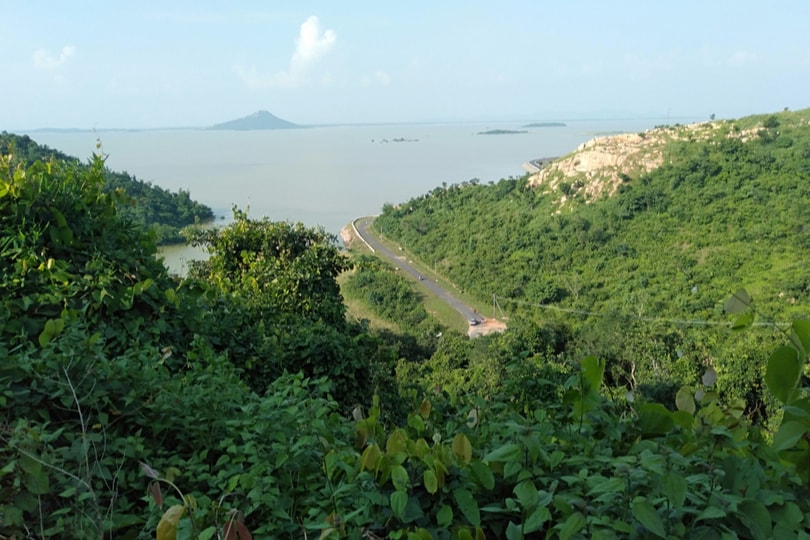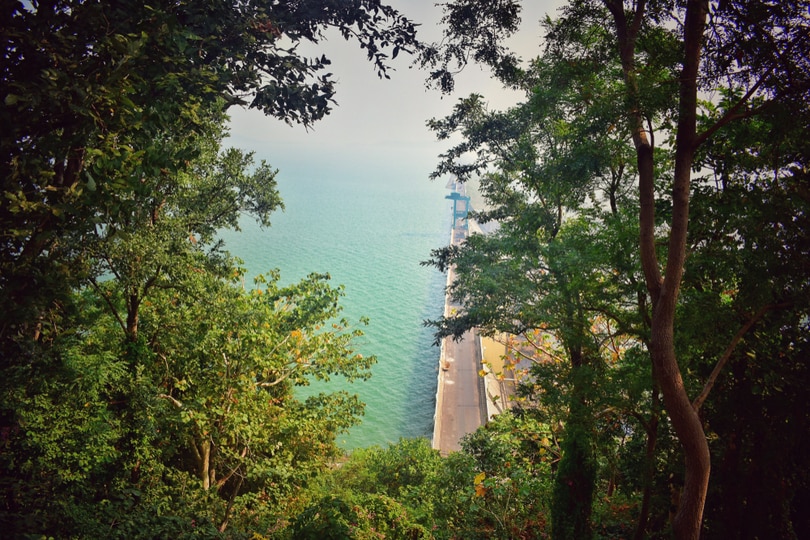Hirakud is the longest earthen Dam in the world and stands across the mighty river, Mahanadi, in the Sambalpur region of Odisha. It was the first major multipurpose river valley project after India’s Independence in 1947. This human-made structure is located 15 km north of Sambalpur – its majesty only rivaled by the sparkling waters of the river it stands on. With an area of 1,33,090 sq km, the Dam is more than twice the area of Sri Lanka. The main Hirakud Dam has an overall length of 4.8 km (3.0 mi), stretching across the Laxmidungri hills on the left and the Chandili Dunguri hills on the right.
The vast expanse of the Dam and its surrounding waters is a sight for sore eyes. Scores of tourists visit the area to take in the views and the engineering marvel that is the Hirakud Dam. The bulk of the Dam contains earth and concrete enough to construct a road 8 meters wide – from Kanyakumari in the south to Kashmir in the north, and further across from Amritsar to Assam!
For the most stunning views of the river, make your way to the top of several rotating minarets nearby. Among these, Gandhi Minar and Nehru Minar provide some of the best views! The Gandhi Minar, in particular, is a watchtower located on top of a hill that offers a bird’s eye view of Hirakud Dam. The soothing and clear waters of the Mahanadi stretch beyond the horizon, blurring the lines between sky and river. And wherever there are enormous stretches of water, beautiful birds always come calling! Hence, Hirakud Dam is a perfect vantage point for birding enthusiasts! So flip open your birding books, whip out those binoculars, and watch these beautiful winged beings to your heart’s content.
You could also take a stroll to the pretty Jawahar Udyan park located below the Dam. The Water Resources Department impeccably maintains both the park and watchtowers.
The reservoir forms the largest artificial lake in Asia with a shoreline of over 640 km that attracts tourists from across the country. The beauty of the Hirakud Dam is best experienced through a stunning twenty-one km drive across the dyke. Cruising along the Dam and the beautiful waters of the Mahanadi is an uplifting and tranquil experience.

The construction of the Dam was proposed by M. Visveswararya to tackle the challenges of devastating floods in the Mahanadi delta. A detailed investigation report was submitted in 1945. Under the leadership of the then President of India, Dr. B. R. Ambedkar, efforts to procure investments began keeping in mind the prospective benefits of constructing the multipurpose Mahanadi Dam. The project was taken up by the Central Waterways, Irrigation, and Navigation Commission.
On 15 March 1946, Sir Hawthorne Lewis, the Governor of Odisha, laid the foundation stone of the Hirakud Dam. Pandit Jawaharlal Nehru laid the first batch of concrete on 12 April 1948.
The upper drainage basin of the Mahanadi River is known for two contrasting phenomena. Periodic droughts on the one hand and floods in the lower delta region, on the other hand, cause extensive damage to crops. The Dam was constructed to help alleviate these challenges by controlling river flow through the drainage system. The Hirakud Dam regulates the flow of the Mahanadi River and produces electricity through several hydroelectric plants. The Dam is a significant source of power generation for the country. Along with power generation, the largest artificial lake in Asia also provides irrigation to the region.
The cost of development and progress is often substantial. In the case of Hirakud, construction led to the complete destruction of several temples which were submerged after the Dam was completed in 1957. If you happen to visit in summer, the receding waters of the Dam will reveal these lost structures underneath. The forgotten stories of these temples have caught the attention of historians. Efforts have begun to document the historical significance of these temples. While many temples have been destroyed after 58 years underwater, around 50 have stood the test of water and time. Their structures resurface now and then, reminding us of lost stories and a different period in time.
Curiosity around the temples piqued with the discovery of two stones etched with the ‘Shila Lekha’ writing. They were recovered from what is believed to be the Padmasini temple. The Padmasini temple was once an important site of worship in what is now the submerged Padmapur village. All the temples located inside the reservoir area were once part of Padmapur. It was one of the oldest and most populous villages in the region before the construction of the Dam.
More than 200 temples were lost in the construction of the Dam. The waters of the Hirakud Dam provide excellent opportunities for archaeology buffs and scuba diving enthusiasts to explore the remnants of forgotten history. The hidden temples are visible to boating visitors during the summer months of May and June.

Ghanteswari Temple is one of the most revered sites in Sambalpur. The shrine received its name from the numerous bells that can be found in and around the temple.
The temple’s main attraction is its location at the convergence of different streams with the mighty Mahanadi river. The waters were known to form whirlpools a long time ago. It was both mesmerizing and tragic since the mighty waters in this location claimed several boats and lives. The construction of the Hirakud Dam has now made the waters around the temple much safer.
Budharaja Temple is an old Shiva temple in the region and a revered pilgrimage destination in the area. The temple contains a sculpture of Budharaja, who is a manifestation of Lord Shiva. The temple is located on top of the Budharaja and can be reached through a long climb of 108 stairs.
The temple comes alive on the occasions of Mahashivaratri and Dussehra, when devotees pay homage to the presiding deity.
Since time immemorial, the mother goddess Samaleswari has been worshipped on the banks of the Mahanadi as Jagatjanani, Adishakti, Mahalaxmi, and Mahasaraswati. Shree Shree Samaleswari is the presiding deity of Sambalpur and a powerful spiritual force in western parts of Odisha and Chhattisgarh.
The Sambalpur region is popularly called Hirkhanda and possesses a rich cultural heritage. According to Tavernier, the French traveler, and Edward Gibbon, the English historian, Sambalpur exported diamonds to Rome.
The Leaning Temple of Lord Shiva at Huma is one of the most famous shrines in the area. The temple stands amid Sal, Segun, Akshmani, Dudhra, and Palash. This unique temple leans 5 to 6 degrees towards a north-easterly direction. The main temple tilts to one direction while other small temples tilt in different directions. Even the boundaries of the temple are tilted in a particular manner. Nobody has come up with an explanation so far for the temple’s unique architecture. However, the most plausible explanation is probably geographical.
The shrine houses Lord Vimaleshwar, who is a manifestation of Lord Shiva. The temple was built during the reign of Baliar Singh, the fifth Raja of Sambalpur dating back to the 5th century B.C. The construction was completed in 1657 under the reign of Ver Ballyar Singh.
According to legend, the worship of Shiva began with the journeys of a milkman who crossed the Mahanadi daily. He would stop at a place on the banks where the underlying rock cropped out. The milkman offered a daily dole of milk, which was at once drunk up by the stone. Soon, word about the miracle spread, which ultimately ended up in the construction of the present temple.
Huma is a sacred place that attracts both pilgrims and curious travelers. On the occasion of Shivratri, a grand fair takes place at the foothill in March every year. The presiding deity is Bimaleswar Siva.
Visitors also come here to observe the particular type of fish in this location called Kudo fish. The fish are reportedly very comfortable around humans. They are known to eat sweets straight out of the hands of people bathing close to the temple. The fish are considered to be assets of God. They swim peacefully around the vicinity of the temple since nobody will even attempt to catch them. They are called by name – especially on auspicious days – and offered the prasad from the temple. Thousands of pilgrims visit the shrine during Shivaratri and other festive occasions.

The best time to visit Hirakud Dam in Sambalpur is from September to March as the weather is mostly pleasant during this time.
By Air: The nearest airports are Swami Vivekananda International Airport, Raipur (265 K.M.), and Biju Patnaik International Airport, Bhubaneswar (300 K.M.).
By Rail: Sambalpur is well-connected by direct trains to major cities across India. There are four Railway stations, namely Sambalpur (Khetrajpur), Sambalpur Road (Fatak), Hirakud, and Sambalpur City in Sambalpur.
By Road: Sambalpur is connected by National Highway 6. This Highway from Mumbai to Kolkata passes through Sambalpur.
Sambalpur is connected to Bhubaneswar through National Highway 42.
Sambalpur has two bus stands – one for private vehicles and the other for Government transport. The Govt. Bus stand is located at Laxmi Talkies Chhaka, and the Private Bus stand is located at Ainthapali, about 3 km from the Govt Bus stand.
Taxis and auto-rickshaws are readily available for visiting Hirakud Dam and other places of interest.

Please go back to portrait mode for the best experience